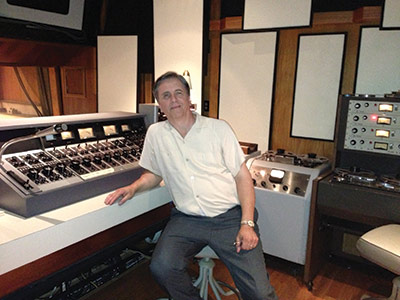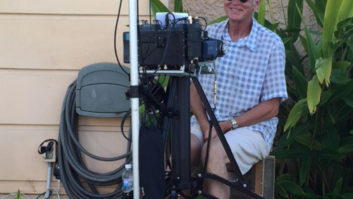
Producer/engineer Mark Linett is no stranger to The Beach Boys’ Pet Sounds, having produced The Pet Sounds Sessions in 1996 and handled the group’s catalog reissues since 1987, as well as engineering most of Brian Wilson’s solo albums. So when producer/director Bill Pohlad wanted to re-create the album’s sessions for his film Love & Mercy, Linett was the perfect choice to act as technical consultant.
“The plan was to film the majority of the studio scenes in the studio where most of The Beach Boys’ records were cut, up until about 1967, which was Western Studios Studio 3 [now EastWest Studios],” Linett says.
To help Pohlad and production designer Keith Cunningham set up the smallish 31×15-foot room as it would have appeared in 1965 during the sessions, Linett conferred with former United Western engineer Joe Sidore, who also supplied photos from the era. “Like you’ll see in the film, the musicians were right on top of each other, which is actually one of the reasons it sounded so good—the mic leakage added to the sound,” he notes.
Studio 3’s current control room features a Trident A Range console and portable racks of modern gear. The latter was easily removed for the production and replaced period pieces, from North Hollywood-based History For Hire, though the Trident was a different matter. The film’s props department built a desk-like Formica enclosure around and over the Trident, allowing Linett to bring in his own period console, which was set on top of it.
The original Studio 3 console, built by studio founder Bill Putnam, was a 12-input, 3-output desk, purchased by musician John Phillips upon its removal in the early 1970s. “There were actually two built at the time. I own the twin sister to the Studio 3 console, which was built to serve as a portable rig,” Linett explains. But it is not the console we see in the film. “The props guy told me, ‘The first rule of this business is, don’t use your own stuff,’” lest one risk damage to historic equipment. Linett instead offered an 8-input, 2-out console built for a radio station in Texas in 1963, which was augmented to house 11 modules, with lights and VU meters that responded to audio playback.
The rig also had a working talkback system, which would not only play actor Paul Dano’s (Wilson) voice into the studio, to be picked up by studio mics by the production sound mixer, but also fed directly to the mixer.
Though original session engineer Chuck Britz passed away in 2000, in keeping with the goal of realism, he is portrayed in the film by another Beach Boys engineer—Linett. “It made sense having me do it, rather than having me teach an actor how to act like an engineer,” he laughs. “I’m playing an engineer, a part I have been ‘rehearsing’ for almost 40 years.”
Original session miking would typically have been limited to 12 mics, to match the limits of the console, save for the odd occasion where supplemental auxiliary mixers might have been used, according to Linett. Again, for authenticity, Linett provided some historic microphones, as did EastWest from their collection; a few others were rented.
While the vocal sessions for “Good Vibrations” were, for the most part, recorded on 8-track at nearby CBS Studios, both that facility and Gold Star were re-created in EastWest’s Studio 1 (including faux control rooms set up in the live room). For that session, says Linett, “CBS was big on AKGs, unlike most studios at the time. So The Beach Boys are always seen singing on C12s, with these large AKG factory windscreens. As luck would have it, I found a couple of those over in the boneyard at Ocean Way, and they let me have them.”
The production hired professional musicians for the venerable Wrecking Crew players Wilson used on the original sessions, such as bassist Carol Kaye, drummer Hal Blaine and others, all guided by current Wilson band musical director Darian Sahanaja.
The session scenes were filmed with musicians playing live and being recorded by the production sound mixer, rather than miming to session material given to production. “It’s shot very much like a documentary,” Linett says. “So you’re hearing them as if you’re in the room. Seeing them play what you’re hearing is actually much more realistic and believable to watch.”
None of the musicians wore headphones, as would have been the case at the time, save for actor Johnny Sneed (Blaine) during the recording of the intro for “Wouldn’t It Be Nice.” “The original session had a Belzuki, which was played by a musician plugged in direct in the control room, so Hal would have had to hear the intro to lead the others into the song,” Linett says.
“We discussed recording the musicians onto multitrack, but in the end we decided it would be too complicated,” he continues. “I would have loved to do it, just to get a sense of what it would have been like to have that kind of palette to play with. Standing in that room, watching them in period costumes and hearing them play, the way the sound was captured, you really get a sense of how it all worked—that huge sound coming out of this small room. It was like going through a time machine.”

